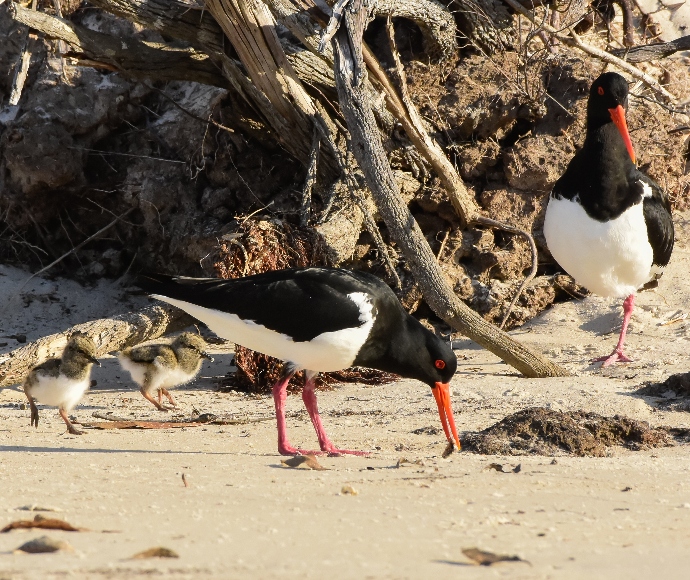The Saving our Species (SoS) program is a significant initiative that unites volunteers, scientists, businesses, community groups, and the NSW Government in a collective effort to safeguard Australia’s distinctive flora and fauna. Below, you’ll find recent highlights of work on the Budawang Coast.
Spring chicks signal start of shorebird season

Two newly hatched, fluffy pied oystercatcher chicks, no bigger than golf balls, were spotted at a beach in the Jervis Bay area last week, the first shorebird chicks to hatch this season on the south coast.
National Parks and Wildlife Service (NPWS) shorebird ranger, Anna Muller, says the one-day-old chicks were spotted by a local volunteer group with the very first feathered family portraits captured by local photographer Chris Grounds.
‘These tiny chicks are a real reminder to the community of the need to share the shore this summer,’ Ms Muller said.
‘While small in size, their hatching is big news for the endangered pied oystercatcher population, with only around 40 fledglings recorded on the New South Wales south coast last season.

Budawangs wallaby grass bounces back
Budawangs wallaby grass has been on the decline for over 50 years due to lack of fire. Fire helps reduce competition for habitat from native shrubs and trees that also grow at the summit of Budawang and Currockbilly mountains.
The critically endangered plant was down to only 100 plants at Mount (Mt) Budawang before the 2019–20 bushfires, but is now thriving after the hot fire event and La Niña rains gave the species a vital boost.
Milton-Ulladulla subtropical rainforest revival

The Milton Ulladulla Subtropical Rainforest Revival project is a local community forest recovery project located on Murramarang lands around Milton on the NSW South Coast that aims to protect Milton Ulladulla subtropical rainforest and expand its range.
The project undertakes actions that target key threats to the rainforest. Working together to protect MUSTR not only benefits this endangered ecological community but also helps the Milton community through supporting improved farm practices, local employment, and community cohesion, particularly after the devastating 2019–2020 bushfires.
Between 2016 and 2022 the project has achieved:
- planting 7500 seedlings over 7 hectares
- a 2.5% increase to the area of the rainforest as a result of the plantings
- 24 hectares of remnants fenced to protect from stock incursion
- weeding of 20 hectares of rainforest.
Critically Endangered fledgling takes long haul flight to North Coast

A rare hooded plover born in Eurobodalla National Park has been spotted 7 months later more than 850 km kilometres north in Broadwater National Park, a massive migration for this mini adventurer.
Hooded plovers are listed as Critically Endangered in New South Wales. A recent census estimate puts the current NSW population at only 65 birds. Despite their distinct black, white and red colouring, hoodies are difficult to spot during nesting season and are very vulnerable to disturbance.
